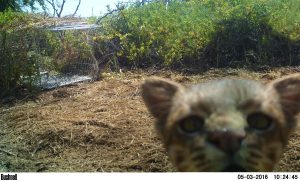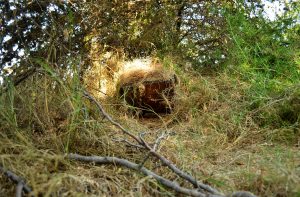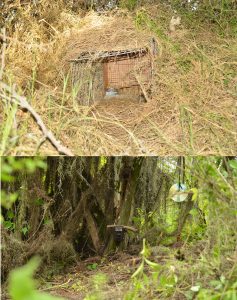 If you ever wrote a grant application, you are familiar with the type of questions asked. In 2015, as part of a felid conservation project, Alvaro García-Olaechea and I were naively writing a grant to study pampas cat (Leopardus colocolo) in the Sechura Desert of northern Peru, and we were asked about our timeframe. We optimistically expected to trap six elusive small wild cats in 6 months, thinking that with 2 weeks of fieldwork in every expedition, we were going to be successful. However, little did we know how these cats are amazingly intelligent, rude, and adorable!
If you ever wrote a grant application, you are familiar with the type of questions asked. In 2015, as part of a felid conservation project, Alvaro García-Olaechea and I were naively writing a grant to study pampas cat (Leopardus colocolo) in the Sechura Desert of northern Peru, and we were asked about our timeframe. We optimistically expected to trap six elusive small wild cats in 6 months, thinking that with 2 weeks of fieldwork in every expedition, we were going to be successful. However, little did we know how these cats are amazingly intelligent, rude, and adorable!
Thus, for anyone with little to no experience with trapping wild cats, here are some tips/experiences to help you decide whether or not you want to embark on this rewarding/challenging/crazy/impossible? task.
Make sure your traps work

 When we asked for advice from an experienced trapper, she suggested Tomahawk traps, which we ordered from a local shop. We tested them with a small house cat, and apparently they worked. During the first night of trapping we realized from camera trapping photos that we caught a cat! But later realized that with just a little push on the door, it was able to escape 🙁
When we asked for advice from an experienced trapper, she suggested Tomahawk traps, which we ordered from a local shop. We tested them with a small house cat, and apparently they worked. During the first night of trapping we realized from camera trapping photos that we caught a cat! But later realized that with just a little push on the door, it was able to escape 🙁
How much camouflage?
 If you are trying to decide how much to hide your traps, different biologists will naturally give you different recommendations, based on their experiences. We heard that leaving the traps by themselves was going to be better, because the bait is what attracts animals – and cats already know that the cages are something different. So, the simpler the better.
If you are trying to decide how much to hide your traps, different biologists will naturally give you different recommendations, based on their experiences. We heard that leaving the traps by themselves was going to be better, because the bait is what attracts animals – and cats already know that the cages are something different. So, the simpler the better.
Burglar alarm?
 Because our goal is to trap the cats with as little stress as possible, we use and recommend trap alarms. These VHF (very high frequency) trap alarms would send a different “bip” frequency when your trap has been activated. They can be a little expensive for small projects, but they are worth every penny. Their wide range can allow researchers to check if the traps have been activated from a long distance, saving you time and strength. The only other tricky decision is how often to listen to your alarms, as this would depend on the weather, the type and locations of the traps. We have found that every 3 hours (day and night) is working well for us.
Because our goal is to trap the cats with as little stress as possible, we use and recommend trap alarms. These VHF (very high frequency) trap alarms would send a different “bip” frequency when your trap has been activated. They can be a little expensive for small projects, but they are worth every penny. Their wide range can allow researchers to check if the traps have been activated from a long distance, saving you time and strength. The only other tricky decision is how often to listen to your alarms, as this would depend on the weather, the type and locations of the traps. We have found that every 3 hours (day and night) is working well for us.
Become a cat whisperer
 Felines are curious carnivores – use this to your advantage! You can use many things to attract them to your traps. You need to keep in mind that cats will have to make to decision, first to come check out your trap, and then to get in. A visual or sound attractor such as CDs or prey calls work to pique their curiosity and entice them to approach your trap. Then, what works best to get them to actually enter your trap is a live prey, usually small chickens, but we also use tuna and cat food. In every attempt you will have to be creative and try to convince them that your trap is worth investigating.
Felines are curious carnivores – use this to your advantage! You can use many things to attract them to your traps. You need to keep in mind that cats will have to make to decision, first to come check out your trap, and then to get in. A visual or sound attractor such as CDs or prey calls work to pique their curiosity and entice them to approach your trap. Then, what works best to get them to actually enter your trap is a live prey, usually small chickens, but we also use tuna and cat food. In every attempt you will have to be creative and try to convince them that your trap is worth investigating.
Final comments
 Thankfully, after 50 days of fieldwork we managed to capture two pampas cats ☺. This is an ongoing project so any suggestions and comments are welcome and appreciated!
Thankfully, after 50 days of fieldwork we managed to capture two pampas cats ☺. This is an ongoing project so any suggestions and comments are welcome and appreciated!
If you would like to follow the project you can do it through Instagram
(https://www.instagram.com/peruvian.desert.cat/) and Facebook (https://www.facebook.com/peruviandesertcat/)
If you are keen to read more about pampas cat perceptions and current distribution here is a new article (https://www.researchgate.net/publication/)
